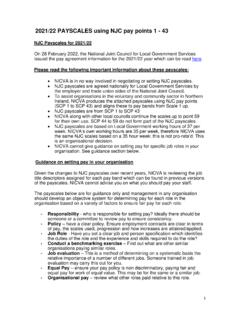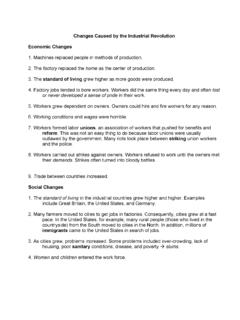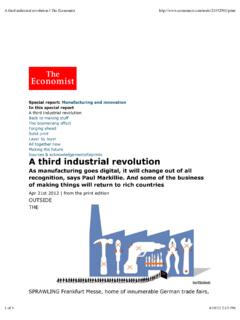Transcription of The Impacts of the Fourth Industrial Revolution on Jobs ...
1 1 The Impacts of the Fourth Industrial Revolution on jobs and the Future of the Third Sector Abstract: According to a January 2016 report from the World Economic Forum (WEF), The Future of jobs : Employment, Skills and Workforce Strategy for the Fourth Industrial Revolution , a host of developments have moved the world of work into the 4th Industrial Revolution which will fundamentally alter the way we live, work, and relate to one another. This paper researched the Impacts of the 4th Industrial Revolution on employment and on the work of voluntary and community organisations, including identifying what new demands and opportunities these developments may present to these organisations. Key words: the Fourth Industrial Revolution ; the third sector 2 Contents Introduction 3 Welcome to the 4th Industrial Revolution 4-5 What Happens With Employment? 6-10 Who Loses, Who Gains?
2 11-14 Opportunities or Challenges for the Third Sector? 15-17 How Transforms the Third Sector? 18-19 So Much More to Discuss 20 References 21-25 3 Introduction Many commentators are increasingly talking about the potential impact of the 4th Industrial Revolution . It will change how we live and how we work, how the economy works and how we are governed. For example, a Citi and Oxford University joint report in 2016 estimated that 57% of jobs across the OECD are at risk of automation, the Financial Times reported in 20161 that between 2000 and 2010, of all the jobs lost in the US, over 85% were lost to new technologies, and the Bank of England estimated that two thirds of all jobs are capable of being automated within 20 years. Regardless of the specific data, an indisputable fact is that the 4th Industrial Revolution has already come, and the current workforce is already feeling the heat.
3 Whilst the business world is already discussing and preparing for how this Revolution will affect their businesses, dubbing it Industry , the wider societal Impacts of this new Revolution have not, to date, been discussed in depth nor planned for. Past Industrial Revolutions have forced society to undergo major and often painful processes of adaptation, for example from rural, largely agricultural societies, to urban, Industrial societies, and then to post- Industrial societies dealing with the loss of traditional industries and sources of employment. The societal Impacts of the 4th Industrial Revolution also appear likely to be far-reaching, resulting not only in the social and economic Impacts of the loss of many current jobs , but also fundamental, and increasingly volatile shifts in the nature of work and future jobs , and in how public and private services will be delivered. The Third Sector has always been at the forefront of meeting societal challenges and needs, ranging from mental health and wider health and social care services, to services for older people, to meeting transport needs in less accessible areas which private or public sector operators could not provide on a commercial or cost-effective basis.
4 The Third Sector is therefore well-placed to play a key role in meeting the wide range of changing societal needs likely to emerge from the 4th Industrial Revolution . 1 4 Welcome to the 4th Industrial Revolution Building on the first Industrial Revolution which used water and steam power to mechanize production, the second which used electric power to create mass production and the third, which used electronics and information technology to automate production; the 4th Industrial Revolution is taking automation to new levels, blurring the lines between the physical, digital, and biological spheres and using technologies to perform tasks previously carried out by humans, ranging from piloting vehicles to rules-based jobs in areas such as accounting and law. Source: 2025: How Will We Work? How Will Your Job Change? When we compare it with previous Industrial Revolutions, we find the dramatic differences between the Fourth Industrial Revolution and the other three.
5 In its scale, scope, and complexity, the transformation will be unlike anything humankind has experienced before. The 4th Industrial Revolution is not merely a prolongation of the Third Industrial Revolution but rather a new and distinct Revolution . Firstly, people can continuously produce new information and generate new knowledge in the mining of information. The possibilities of billions of people connected by mobile devices, with unprecedented processing power, storage capacity, and access to knowledge, are unlimited. We can record a person's daily life through their mobile phone location. When this data is monitored for a long period of time, we can get to know a person s lifestyle habits, such as their work place, the supermarkets they shop in, the restaurants where they dine, the times they do so, and even their personal preferences. This technology will allow the intelligence level of machines to increase through continuous data accumulation and analysis. 5 Secondly, the Industrial Revolution represents not only a huge advance in technology and in the improvement of productivity, but will also transform modes of production and the relationships between elements of production processes.
6 The 4th Industrial Revolution , by enabling the complete communication of all relevant information at every stage in the production chain, creates separate production sectors for each process and informs how they relate to each other, bringing together such processes as inventory taking, improving production efficiency, saving energy and reducing emissions, thus making the manufacturing industry part of the information industry. At the same time, it can make production flexible and allow mass customization, enabling different products to be produced in a production line, which will revolutionize the warehousing, transportation and the whole manufacturing industry. Thirdly, the 4th Industrial Revolution will spawn a new economic form, the sharing economy. A typical example of sharing economy is ride-hailing online services, such as Uber and the Chinese Didi service, which allow customers to obtain taxis services from private car owners. The impact of this new form is disruptive, not only to the taxi industry, but also the whole transportation industry.
7 (Maybe in the near future, we won't need drivers at all and unpiloted vehicles will fill the streets.) The Impacts of the sharing economy are not limited to online ride-hailing services, but also include the shared space service, Airbnb, and the global online work platform, AAwork. From the shared motors and houses, to the shared umbrellas, basketballs, toys, clothing and jewelry, the sharing economy is constantly updating, and will be very profound and revolutionary. Last but not least, as the economists Erik Brynjolfsson and Andrew McAfee have pointed out, the Revolution could yield greater inequality, particularly in its potential to disrupt labor markets. With the growth of automation, robots and computers will replace workers across a vast spectrum of industries. Low-skill/low-pay jobs will disappear and the poor will face tougher challenges, which in turn will lead to an increase in social tensions. In a strict sense, this is not a unique feature of the Fourth Industrial Revolution .
8 Historically, Industrial Revolutions have always begun with greater inequality followed by periods of political and institutional change. However, mankind will face a more serious challenge in this Revolution , because it is robots and computers that take our jobs , not the flow of labour between different sectors. 6 What Happens with Employment? The characteristics of the Fourth Industrial Revolution are destined to bring about different Impacts on employment, which are no longer confined to one industry, but all industries. At the same time, a lot of jobs will disappear, but there will be a lot of new job requirements. It is expected that more than 65% of children entering primary school today will end up working in completely new jobs that currently do not exist when they enter the workplace 15 years from now. As the changes brought by the social media, digital publications and e-commerce, the most in-demand occupations did not exist 10 or even five years ago. According to the Future of Employment report, around 47 percent of total US employment is in the high risk category.
9 People may be more concerned about what types of jobs are at high risk than specific Numbers. So which jobs are at greatest risk? What jobs will be safe in the future? Researchers at Oxford University published a widely referenced study in 2013 on the likelihood of computerization for different occupations. Out of around 700 occupations, here are the top 30 most risky occupations having a 98-99 per cent chance of being automated in the future: 1 Telemarketers 2 Title Examiners, Abstractors, and Searchers 3 Sewers, Hand 4 Mathematical Technicians 5 Insurance Underwriters 6 Watch Repairers 7 Cargo and Freight Agents 8 Tax Preparers 9 Photographic Process Workers and Processing Machine Operators 10 New Accounts Clerks 11 Library Technicians 12 Data Entry Keyers 13 Timing Device Assemblers and Adjusters 14 Insurance Claims and Policy Processing Clerks 15 Brokerage Clerks 16 Order Clerks 7 17 Loan Officers 18 Insurance Appraisers, Auto Damage 19 Umpires, Referees, and Other Sports Officials 20 Tellers 21 Etchers and Engravers 22 Packaging and Filling Machine Operators and Tenders 23 Procurement Clerks 24 Shipping, Receiving, and Traffic Clerks 25 Milling and Planing Machine Setters, Operators, and Tenders, Metal and Plastic 26 Credit Analysts 27 Parts Salespersons 28 Claims Adjusters, Examiners, and Investigators 29 Driver/Sales Workers 30 Radio Operators On the other hand.
10 The following list comprises the top 30 most safe occupations with a per cent or less probability of being computerized based on current technology. 1 Recreational Therapists 2 First-Line Supervisors of Mechanics, Installers, and Repairers 3 Emergency Management Directors 4 Mental Health and Substance Abuse Social Workers 5 Audiologists 6 Occupational Therapists 7 Orthotists and Prosthetists 8 Healthcare Social Workers 8 9 Oral and Maxillofacial Surgeons 10 First-Line Supervisors of Fire Fighting and Prevention Workers 11 Dietitians and Nutritionists 12 Lodging Managers 13 Choreographers 14 Sales Engineers 15 Physicians and Surgeons 16 First-Line Supervisors of Transportation and Material-Moving Machine and vehicle operators 17 Instructional Coordinators 18 Psychologists, All Other 19 First-Line Supervisors of Police and Detectives 20 Dentists, General 21 Elementary School Teachers, Except Special Education 22 Medical Scientists, Except Epidemiologists 23 Education Administrators, Elementary and Secondary School 24 Podiatrists 25 Clinical, Counseling.









